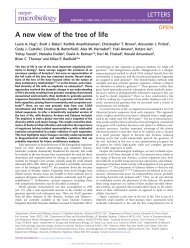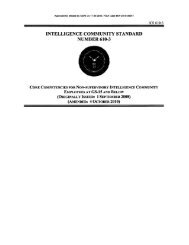The Joint Force in a Contested and Disordered World
JCS-JOE-2035
JCS-JOE-2035
Create successful ePaper yourself
Turn your PDF publications into a flip-book with our unique Google optimized e-Paper software.
lead to new means of signature control, the development of low-probability <strong>in</strong>tercept active<br />
sensors, the application of high-resolution planar lenses, <strong>and</strong> the use of compact antennas.<br />
Exploitation of unique material properties at the nanoscale. <strong>The</strong> ability to make <strong>and</strong> modify<br />
materials at the nanoscale will allow manufacturers to take advantage of many new properties.<br />
Anticipated advances <strong>in</strong> nanomaterial technologies (comb<strong>in</strong>ed with parallel improvements <strong>in</strong><br />
metamaterials) suggest that more complex composites <strong>and</strong> bespoke materials will emerge with<br />
properties eng<strong>in</strong>eered precisely to optimize performance.<br />
Fuels <strong>and</strong> batteries with <strong>in</strong>creased energy density. Advances <strong>in</strong> energy systems (particularly<br />
those based on hydrocarbons) will likely be evolutionary, <strong>and</strong> expected improvements <strong>in</strong><br />
energy density may enable advances <strong>in</strong> directed energy weapons, <strong>in</strong>crease the loiter time of<br />
unmanned vehicles, lead to more effective sensors, <strong>and</strong> reduce the size <strong>and</strong> weight of manportable<br />
systems.<br />
Biochemistry <strong>and</strong> biological eng<strong>in</strong>eer<strong>in</strong>g. New techniques to edit <strong>and</strong> modify the genome<br />
may allow scientists to harness organisms or biological systems as weapons or to perform<br />
eng<strong>in</strong>eer<strong>in</strong>g tasks typically impractical with conventional methods. Future advances might<br />
<strong>in</strong>clude the construction of new biological parts, bra<strong>in</strong>-computer <strong>in</strong>terfaces, or the re-design<br />
of natural biological systems to manufacture drugs, chemicals, materials, or food.<br />
Economic <strong>and</strong> military advantages will accrue to those nations with dense university clusters, a<br />
community of bus<strong>in</strong>esses that transform primary research <strong>in</strong>to usable prototypes, <strong>and</strong> education<br />
systems that encourage collaboration, experimentation, <strong>and</strong> <strong>in</strong>novation. Furthermore, because<br />
research clusters are frequently <strong>in</strong>ternational <strong>in</strong> nature, novel scientific advances may not be<br />
claimed by s<strong>in</strong>gle nations. <strong>The</strong> United States must focus on underst<strong>and</strong><strong>in</strong>g the areas that research<br />
clusters are <strong>in</strong>vestigat<strong>in</strong>g <strong>and</strong> be will<strong>in</strong>g to explore how the application of multidiscipl<strong>in</strong>ary<br />
scientific discoveries might augment <strong>and</strong> upgrade (or erode <strong>and</strong> obsolesce) its current portfolio of<br />
capabilities. Future force development activities must be capable of <strong>in</strong>teract<strong>in</strong>g with research<br />
clusters, <strong>and</strong> encourag<strong>in</strong>g these clusters to research technologies that may lead to dist<strong>in</strong>ct U.S.<br />
military advantages.<br />
<strong>The</strong> Significance of Systems <strong>and</strong> Systems Integration<br />
<strong>The</strong> corollary to change <strong>in</strong> multidiscipl<strong>in</strong>ary basic research at the eng<strong>in</strong>eer<strong>in</strong>g level is the<br />
importance of systems <strong>in</strong>tegration to make emerg<strong>in</strong>g technologies economically or militarily<br />
useful. Effective technology <strong>in</strong>tegration <strong>in</strong>to military operations requires the capacity to br<strong>in</strong>g<br />
together many different capabilities <strong>in</strong>to a coherent, purposeful whole. Even today, the largest,<br />
most capable states struggle to match their ability to develop <strong>in</strong>dividual technologies with the<br />
ability to <strong>in</strong>tegrate these technologies <strong>in</strong>to a s<strong>in</strong>gle system. By 2035, improvements to <strong>in</strong>dividual<br />
devices, tools, or platforms will likely become less important than the system architectures which<br />
allow dissimilar capabilities to work together coherently.<br />
<strong>The</strong> significance of systems <strong>and</strong> systems <strong>in</strong>tegration is likely to result from several important<br />
trends:<br />
Additive manufactur<strong>in</strong>g goes global. Additive manufactur<strong>in</strong>g processes <strong>in</strong> both the<br />
commercial <strong>and</strong> government sectors will likely grow <strong>and</strong> proliferate to an array of competitor<br />
states, terrorists, <strong>and</strong> crim<strong>in</strong>als. <strong>The</strong>se capabilities will permit the mass customization of parts,<br />
the development of lighter <strong>and</strong> stronger components, the use of rapid reverse-eng<strong>in</strong>eer<strong>in</strong>g, <strong>and</strong><br />
a reduced need for expensive <strong>and</strong> vulnerable supply cha<strong>in</strong>s <strong>and</strong> warehous<strong>in</strong>g facilities.<br />
16











